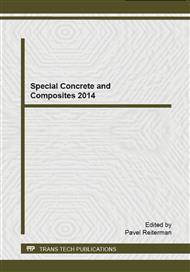[1]
Kynčlová, M., Hájek, P., Fiala, C. Utilization of high performance silicate composites in material effective building structures. Grada, 2010, pp.411-414. ISBN 978-80-247-3624-2.
Google Scholar
[2]
Kolář, K., Reiterman, P., Klečka, T., Dudíková, M., Huňka, P. Surface Layer Study of Concrete Containing Metakaolin. CRC Press/Balkema, 2010, pp.675-692. ISBN 978-0-415-59318-2.
DOI: 10.1201/b10552-83
Google Scholar
[3]
Reiterman, P., Holčapek, O., Čáchová, M., Vogel, F., Jogl, M., Konvalinka P., 2014, Basic and Hygric Properties of Concrete Containing Fine Ceramic Powder, Advanced Materials Research, Vol. 897, pp.188-191.
DOI: 10.4028/www.scientific.net/amr.897.188
Google Scholar
[4]
Vejmelková, E., Černý, R., Ondráček, M., Sedlmajer, M. Fine-Ground Ceramics as Alternative Binder in High Performance Concrete. WIT Transactions on the Built Environment, 2010, Vol. 112, pp.91-98. ISSN 1743-3509.
DOI: 10.2495/hpsm100091
Google Scholar
[5]
Mármol I., Ballester P., Cerro S., Monrós G., Morales J., Sánchez L. Use of granite sludge wastes for the production of coloured cement-based mortars, Cement & Concrete Composites 2010, Vol. 32, p.617 – 622.
DOI: 10.1016/j.cemconcomp.2010.06.003
Google Scholar
[6]
Pera J., Boumaza R., Ambroise J. Development of a pozzolanic pigment from red mud, Cem Concr Res 1997, Vol. 27, No. 10, pp.1513-1522.
DOI: 10.1016/s0008-8846(97)00162-2
Google Scholar
[7]
López A., Tobes J.M., G. Giaccio G., Zerbino R. Advantages of mortar-based design for coloured self-compacting concrete; Cement & Concrete Composites 2009, Vol. 31, p.754–761.
DOI: 10.1016/j.cemconcomp.2009.07.005
Google Scholar
[8]
Dvořák, K., 2014, Influence of different grinding types on granulometry of cement grains. Advanced Materials Research, Vol. 897, pp.34-38. ISSN 1022-6680.
DOI: 10.4028/www.scientific.net/amr.897.34
Google Scholar
[9]
Máca, P., Jandeková, D., Konvalinka, P., The influence of metakaolin addition on the scaling of concrete due to frost action. Cement Wapno Beton, (2014), Vol. 19, no. 1, pp.1-7. ISSN 1425-8129.
Google Scholar
[10]
Reiterman, P., Kostelecká, M., Kolář, K., Konvalinka, P., 2013, Application of Laser Microscope System for Evaluation of Separation Agents, Applied Mechanic and Materials, Vol. 241-244, pp.517-524. ISSN 1660-9336. ISBN 978-3-03785-545-4.
DOI: 10.4028/www.scientific.net/amm.241-244.517
Google Scholar
[11]
Lee H., Lee J., Yu M. Influence of iron oxide pigments on the properties of concrete interlocking blocks, Cem Concr Res 2003, Vol. 33, p.1889–1896.
DOI: 10.1016/s0008-8846(03)00209-6
Google Scholar
[12]
Von Szadkowski G. The effect of pigments on the quality of concrete blocks, Proc. 1st Int. Conf. CBP, Newcastle-Upon-Tyne, England 1980, p.155– 156.
Google Scholar
[13]
Collepardi M, Passuelo A. The best SCC: stable, durable and colourable. In: Helene P, Holland TC, Pazzini E, Bittecourt R, editors. Proceeding IV international ACI/CANMET conference on quality of concrete structures and recent advances in concrete materials and testing. Furnas Centrais Elétricas S.A. –Civil Engineering Technological Center–Goiânia, Brasil; 2005.
Google Scholar
[14]
Svarcova, S., Bezdicka, P., Hradil, D., Hradilova, J., Zizak, I., Clay pigment structure characterisation as a guide for provenance determination-a comparison between laboratory powder micro-XRD and synchotron radiation XRD, ANALYTICAL AND BIOANALYTICAL CHEMISTRY 399 (2011).
DOI: 10.1007/s00216-010-4382-4
Google Scholar
[15]
Bruce S.M., Rowe G.H.; The influence of pigments on mix designs forblock paving units, Proceedings of the 4th International Conference on Concrete Block Paving 2, Pave New Zealand '92, New Zealand, 1992, p.117–124.
Google Scholar
[16]
Lee H., Lee J., Yu M.; Influence of inorganic pigments on the fluidity of cement mortars, Cem Concr Res 2005; Vol. 35(4),: p.703–10.
DOI: 10.1016/j.cemconres.2004.06.010
Google Scholar
[17]
Carvalho de Arruda Coelho F.: The effect of the addition of inorganic pigmentation on the durability of the concrete, BETON TKS 4/2009, str. 44–47.
Google Scholar
[18]
Vejmelková, E., Koňáková, D., Čáchová, M., Černý, R., Keppert, M., Effect of hydrophobization on the properties of lime-metakaolin plasters, Construction and Building Materials, 2012, Vol. 37, no. 1, pp.556-561.
DOI: 10.1016/j.conbuildmat.2012.07.097
Google Scholar
[19]
da Silva, W., R., L., Lucena, D., S., Stemberk, P., Prudencio, L., R., Evaluation of the effect of concrete compositional changes and the use of ethyl-alcohol and biodegradable-oil-based release agents on the final surface appearance of self-compacting concrete precast elements, Construction and Building Materials, 2014, Vol. 52, no. 1, pp.202-208.
DOI: 10.1016/j.conbuildmat.2013.10.102
Google Scholar


